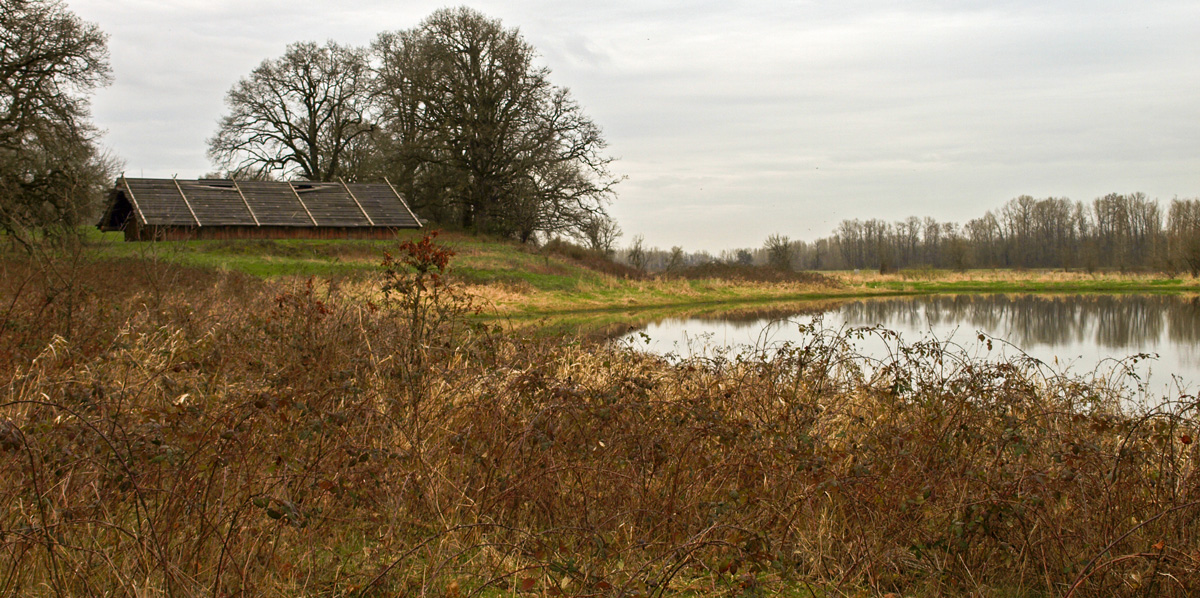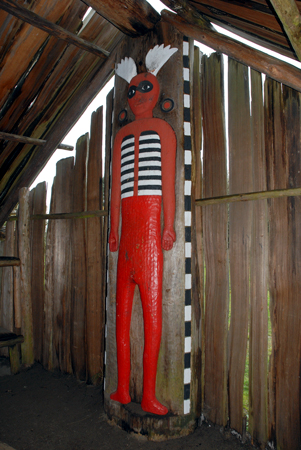Paddling up the Columbia River becomes increasingly difficult, but they manage fifteen miles and encamp near present Ridgefield, Washington. The captains describe the dress, houses, wapato trade, and customs of the Nahpooitle (Cathlapotle) villagers.
Wild Chives and Wapato
by Yellowstone Public Radio[1]Originally aired weekdays by Yellowstone Public Radio during the Bicentennial observance of 2003-2006. Narrated by Hal Hansen. Scripts by Whit Hansen and Ed Jacobson. Produced by Leni Holliman. © … Continue reading
Cathlapotle Plankhouse (reconstruction)
© 30 March 2009 by Kristopher K. Townsend. Permission to use granted under the Creative Commons Attribution-Share Alike 4.0 International license.
Nahpooitle (Cathlapotle) Village
we arrived at the village of the Cath-lah-poh-tle wich consists of 14 large wooden houses. here we arrived at 3 P. M. the language of these people as well as those on the inlet and wappetoe Island differs in some measure from the nations on the lower part of the river. tho’ many of their words are the same, and a great many others with the difference only of accent.
—Meriwether Lewis
Plankhouse Sculpture
they are also fond of sculpture. various figures are carved and painted on the peices which support the center of the roof, about their doors and beads.
—Meriwether Lewis
Great Beggars
we purchased a considerable quantity of wappetoe, 12 dogs, and 2 Sea otter skins of these people. they were very hospitable and gave us anchovies and wappetoe to eat. notwithstanding their hospitality if it deserves that appellation, they are great begers, for we had scarcely finished our repast on the wappetoe and Anchovies which they voluntarily set before us before they began to beg. we gave them some small articles as is our custom on those occasions with which they seemed perfectly satisfyed. we gave the 1st Cheif a small medal, which he soon transfered to his wife.
—Meriwether Lewis
Harvesting Wapato
in this pond the nativs inform us they Collect great quantities of pappato, which the womin collect by getting into the water, Sometimes to their necks holding by a Small canoe and with their feet loosen the wappato or bulb of the root from the bottom from the Fibers, and it imedeately rises to the top of the water, they Collect & throw them into the Canoe, those deep roots are the largest and best roots.
—William Clark
Wapato Trade
the wappetoe furnishes the principal article of traffic with these people which they dispose of to the nations below in exchange for beads cloth and various articles. the natives of the Sea coast and lower part of the river will dispose of their most valuable articles to obtain this root.
—Meriwether Lewis
Weather Diary
Aspect of the weather at Rise
Wind at rise
Aspect of weather at 4 O’Ck P. M. Wind at 4 OCk. P. M. cloudy after rain & fair S. cloudy after rain S W frequent showers through the night. very cold this morning.—
—Meriwether Lewis[2]To assist the reader, the editor of this web page has omitted the “Day of the Month” column and spelled out some abbreviations.
Ridgefield National Wildlife Refuge is a High Potential Historic Site along the Lewis and Clark National Historic Trail managed by the U.S. National Park Service. In addition to wildlife viewing, the Cathlapotle plankhouse re-construction is also located here.
Notes
| ↑1 | Originally aired weekdays by Yellowstone Public Radio during the Bicentennial observance of 2003-2006. Narrated by Hal Hansen. Scripts by Whit Hansen and Ed Jacobson. Produced by Leni Holliman. © 2003 by Yellowstone Public Radio. |
|---|---|
| ↑2 | To assist the reader, the editor of this web page has omitted the “Day of the Month” column and spelled out some abbreviations. |




